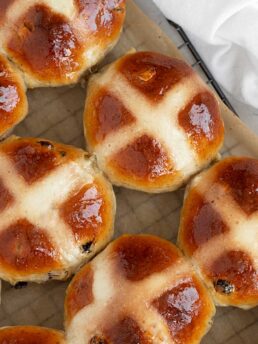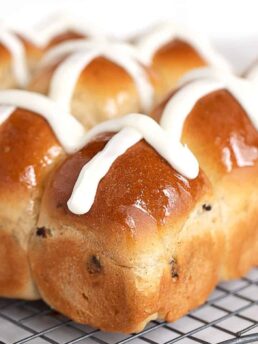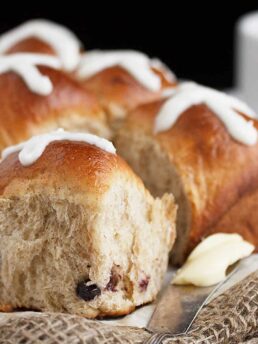Classic hot cross buns with a lemon twist. Lemon zest flavours the buns and the tops are brushed with lemon curd when warm from the oven.

While I love a traditional hot cross bun, I also love to try new flavour twists on the classic. These lemon hot cross buns are just that. I love that there is enough of the traditional flavours to have make no mistake that it is a hot cross bun, but with the fresh hit of lemon as well.
Ingredients and substitutions
A few notes about the key ingredients …
Bread flour – Bread flour is recommended for the best results. If you only have all-purpose flour on hand, you can use it in a pinch though there will be some affect on the finished texture of the buns.
Sultanas – While sultanas are specified, you can substitute other raisins, such as Thompson, Golden raisins or even currants. You could also use a mixture of different raisins. You can adjust the amount of raisins in the dough to your taste without adjusting anything else.
Mixed citrus peel – You either love it or you hate it. Mixed peel is dried and sugared citrus peel, usually lemon, orange and lime. If can often be found in the baking aisle at the grocery store or at Bulk Barn in Canada. If you are in the love-it camp, go add a bit to the dough with the raisins for an extra bit of citrus flavour. If not, simply omit it.
Lemon zest – Lemon zest added to the dough brings a nice, bright note to these buns. If not using the mixed citrus peel, you could add a touch more.
Lemon curd – You can certainly use store-bought lemon curd here or make your own with my lemon curd recipe that I’ve also linked in the Recipe Card.
How to make lemon hot cross buns



- Mix the hot cross bun dough together. If using the mixed peel add it at the end of mixing.
- Add the plumped (soaked) raisins to the dough and mix in.
- Set the dough into a greased and covered bowl to rise until doubled, about 1 1/2 hours.



- Gently deflate the dough then weigh the dough ball.
- Divide the total weight of the dough ball by 12 to get the weight for each bun, then weigh the buns out.
- Form the dough pieces into balls by pinching together tightly underneath.



- Place the formed buns onto a parchment-lined baking sheet (a 9×13-inch sheet works well). Cover and let rise until puffy, about 45-60 minutes.
- Mix up the flour and water paste and pipe a cross on top of the buns before baking.
- After baking, remove the buns immediately to a cooling rack and brush them with lemon curd while they are still hot from the oven.
Recipe tips!
- To avoid hard flour crosses, keep the flour and water paste a bit on the loose side. Not so much that the paste will drip or run off the buns though. A kitchen scale for weighing the flour is helpful. The rule of thumb is to use an equal weight of flour in grams to millilitres of water (so 60 grams of flour to 60 ml of water).
- You don’t need a piping bag to pipe the flour crosses on top. Simply use a plastic zipper bag and snip off the corner.
- You can do an overnight second rise if you like and bake off in the morning. but be warned, you need to take them out of the fridge to warm and rise for at least a couple of hours before baking, so plan for that.
- I’ve linked up my easy whole egg lemon curd recipe in the Recipe Card. Make a 1/2 batch (use the “1/2” button in the recipe card to halve the ingredients). Use the bit of extra lemon curd for spooning onto the buns instead of butter.
Variations
These buns offer a few opportunities for adaptation …
- If you don’t feel like making lemon curd, you can make a lemon and sugar simple syrup and brush it on top after baking instead. Simply bring 1/2 cup water and 1/2 cup white granulated sugar to a boil in a saucepan. Once boiling, remove from the heat and stir in the juice of 1/2 a lemon.
- If you are a lover of mixed citrus peel, add as much or as little as you like. If peel is not your thing, simply omit it and add a bit more lemon zest to the dough instead.
- Finally, you can skip the flour crosses and ice these with an icing sugar and lemon juice icing cross.

Making ahead, storing and freezing
Hot cross buns are best enjoyed on the day they are baked. Next-day buns can be softened by re-heating a bit in the microwave.
For longer storage wrap tightly and freeze for up to 3 months.
Want to save this recipe?
Enter your email and I’ll send it to your inbox. Plus, you’ll get great new recipes from me every week!
By submitting this form, you consent to receive emails from Seasons and Suppers.
You can unsubscribe at any time.

Get the Recipe: Lemon Hot Cross Buns
Ingredients
- 3 1/2-4 cup (425-500 g) bread flour, spooned and levelled *see Note 1 below
- 1/3 cup butter, cold, cut into cubes
- 1 cup + 1 1/2 Tablespoons (275 ml) milk, warmed lukewarm, about 105F
- 2 1/4 teaspoons Active dry or instant yeast
- 3 Tablespoons white granulated sugar
- 1 teaspoon cinnamon
- 1 teaspoon nutmeg
- 1 teaspoon allspice
- 1 teaspoon mace, can omit and add 1/3 tsp more of the other spices instead
- 2-3 teaspoons lemon zest
- 1 1/2 cups sultanas (raisins), plumped
- 1/4-1/3 cup mixed citrus peel, optional *see Note 2 below
Flour crosses:
- 1/4 cup (60 g) all-purpose flour, spooned and levelled
- 1/4 cup (60 ml) water, room temperature
For brushing after baking:
- 3-4 Tablespoons lemon curd, *see Note 3 below
Instructions
- Place the raisins in a small bowl and cover with hot water. Let soak while you start the dough. If using the mixed peel, add it to the bowl with the raisins.
- Heat the milk in the microwave or a small saucepan until just lukewarm (105F). Add the yeast to the milk, stir and let stand.
- Add 3 1/2 cups to the bowl of a stand mixer fitted with the paddle attachment (or to a large bowl if making by hand). Add the cubed butter to the flour and use the paddle attachment on low speed to rub the butter into the flour until the mixture has a breadcrumb texture. If making by hand, rub the butter in with your fingertips.
- Add the milk to the bowl with flour, along with the spices and lemon zest. Mix together with the paddle attachment until combined. Remove the paddle attachment, scraping any dough on the paddle back into the bowl. Place the kneading hook onto the mixer.
- Knead the dough with the kneading hook on Speed 2 for 5 minutes. As the dough starts to come together, it should begin wrapping the kneading hook and clearing the bowl. If it is not, start adding additional flour in small increments, kneading in between additions until you have a smooth, moist but not sticky dough that wraps the dough hook and cleans the bowl.
- Drain the raisins (and peel, if using) and pat dry. Add to the dough and knead them in until well distributed in the dough. Sometimes adding a Tablespoon of flour with the raisins helps them incorporate more easily.
- Remove the dough to a lightly floured work surface. Knead briefly, adding additional flour only if the dough is sticking to your hands or the work surface. Form the dough into a ball and place it into a greased bowl. Cover with plastic wrap and let rise until doubled in size, about 1 1/2 hours.
- TIp! If making your own lemon curd, you can easily cook it up while the dough is rising. Transfer the lemon curd to the refrigerator until needed.
- Remove the dough to a lightly floured work surface and gently deflate. If you have a kitchen scale, weigh the dough ball, then calculate the weight for 12 pieces and weigh the individual pieces out. If you don't have a scale, divide the dough ball into 12 equal-sized pieces.
- Form each piece of dough into a ball by pinching together underneath, creating a smooth and tight top. Place the balls onto the baking sheet pinched-side down. Place the dough balls in four rows of 3 across, evenly spacing them on the baking sheet. There should be an inch or so between them.
- Line a 9×13-inch baking sheet with parchment paper. set aside.
- Spray a large sheet of plastic wrap with cooking spray. Place the plastic wrap sprayed side down over the top of the baking sheet and buns. Allow to rise until puffy and almost doubled, about 45-60 minutes.
- Preheat the oven to 400F (non-convection/not fan-assisted).
- Tip! The consistency of the flour paste for the crosses should not be too thick or too thin. If it is too thick, it will be hard to pipe and may become hard and tough when baked. If it is too thin, it will run off the buns when piped. Start mixing the paste by adding the flour to the bowl and adding just as much water as needed to get the right consistency.
- When the buns have risen, remove the plastic wrap. Add the flour for the flour crosses to a small bowl. Add the water a bit at a time, stirring together until smooth and an easily pipe-able consistency. Spoon the paste into a disposable piping bag or a zipper bag with the end or corner snipped off to make a 1/4-inch opening. Pipe the crosses on top of the buns.
- Place the tray of buns into the oven and bake until deep golden and at least 195F internal temperature, about 25 minutes.
- Remove from the oven. Transfer the buns to a wire cooling rack. Spoon with lemon curd while still hot. Allow to cool completely before slicing.
- Hot cross buns are best enjoyed on the day they are baked. Store in an airtight container for another day. Reheating in the microwave will soften them up. You can also freeze the baked buns. Wrap tightly and freeze for up to 3 months.
Notes
More hot cross bun recipes to love!
Hi! I’m Jennifer, a home cook schooled by trial and error and almost 40 years of getting dinner on the table! I love to share my favourite recipes, both old and new, together with lots of tips and tricks to hopefully help make your home cooking enjoyable, stress free, rewarding and of course, delicious!






